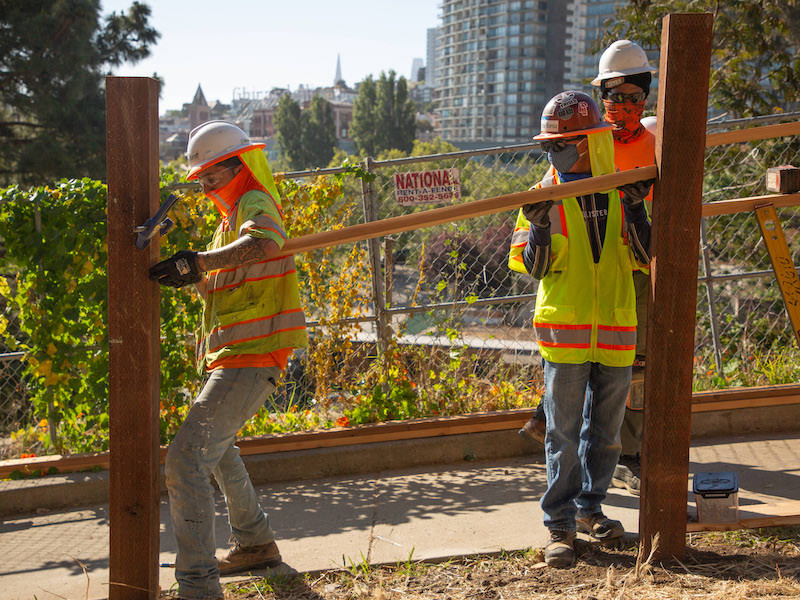Construction employment in August remained below the levels reached before the pre-pandemic peak in February 2020 in 39 states, according to an analysis by the Associated General Contractors of America of government employment data released today. Association officials urged the House of Representatives to quickly pass the bipartisan infrastructure bill to avoid further cutbacks in construction activity and jobs.
“Construction employment slipped or stagnated from July to August in half the states as the delta variant of COVID-19 affected workers and caused some owners to delay projects,” said Ken Simonson, the association’s chief economist. “In addition, more than half of the respondents in our latest workforce survey reported experiencing projects that have been canceled, postponed, or scaled back.”
From February 2020—the month before the pandemic caused project shutdowns and cancellations—to last month, construction employment increased in only 11 states and the District of Columbia. Texas shed the most construction jobs over the period (-56,700 jobs or -7.3%), followed by New York (-50,700 jobs, -12.4%) and California (-34,900 jobs, -3.8%). Wyoming recorded the largest percentage loss (-16.6%, -3,800 jobs), followed by Louisiana (-14.4%, -19,700 jobs) and New York.
Utah added the most construction jobs since February 2020 (7,400 jobs, 6.5%), followed by North Carolina (4,500, 1.9%), Idaho (3,700 jobs, 6.7%), and South Carolina (3,700 jobs, 3.5%). The largest percentage gains were in South Dakota (7.1%, 1,700 jobs), followed by Idaho and Utah.
From July to August construction employment decreased in 22 states, increased in 25 states and D.C., and was unchanged in three states. The largest decline over the month occurred in Kansas, which lost 2,400 construction jobs or 3.7%. Georgia lost the second-most jobs (-2,300 jobs, -1.1%). The second-largest percentage decline since July, -2.1%, occurred in Alabama (-1,900 jobs) and Wyoming (-400 jobs).
Nevada added the most construction jobs between July and August (3,000 jobs, 3.3%), followed by New York (2,600 jobs, 0.7%) and Tennessee (2,600 jobs, 2.0%). New Hampshire had the largest percentage gain (4.4%, 1,200 jobs), followed by Nevada and Oklahoma (2.3%, 1,800 jobs).
Association officials warned that construction employment was being impacted in many parts of the country because of supply chain challenges and growing market uncertainty caused by the resurgent Delta variant. They said new federal infrastructure investments would provide a needed boost in demand and help put more people to work in construction careers.
“It is vital that Congress complete work on the bipartisan infrastructure bill before the end of month,” said Stephen E. Sandherr, the association’s chief executive officer. “Otherwise, funding will stop for much-needed highway and other public works projects and many more construction workers will lose their jobs.”
View state February 2020-August 2021 data and rankings, 1-month rankings. View AGC’s survey results.
Related Stories
Industry Research | Aug 29, 2019
Construction firms expect labor shortages to worsen over the next year
A new AGC-Autodesk survey finds more companies turning to technology to support their jobsites.
Market Data | Aug 21, 2019
Architecture Billings Index continues its streak of soft readings
Decline in new design contracts suggests volatility in design activity to persist.
Market Data | Aug 19, 2019
Multifamily market sustains positive cycle
Year-over-year growth tops 3% for 13th month. Will the economy stifle momentum?
Market Data | Aug 16, 2019
Students say unclean restrooms impact their perception of the school
The findings are part of Bradley Corporation’s Healthy Hand Washing Survey.
Market Data | Aug 12, 2019
Mid-year economic outlook for nonresidential construction: Expansion continues, but vulnerabilities pile up
Emerging weakness in business investment has been hinting at softening outlays.
Market Data | Aug 7, 2019
National office vacancy holds steady at 9.7% in slowing but disciplined market
Average asking rental rate posts 4.2% annual growth.
Market Data | Aug 1, 2019
Nonresidential construction spending slows in June, remains elevated
Among the 16 nonresidential construction spending categories tracked by the Census Bureau, seven experienced increases in monthly spending.
Market Data | Jul 31, 2019
For the second quarter of 2019, the U.S. hotel construction pipeline continued its year-over-year growth spurt
The growth spurt continued even as business investment declined for the first time since 2016.
Market Data | Jul 23, 2019
Despite signals of impending declines, continued growth in nonresidential construction is expected through 2020
AIA’s latest Consensus Construction Forecast predicts growth.
Market Data | Jul 20, 2019
Construction costs continued to rise in second quarter
Labor availability is a big factor in that inflation, according to Rider Levett Bucknall report.
















